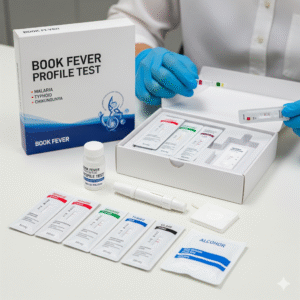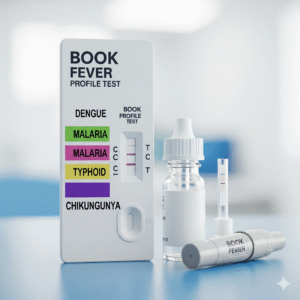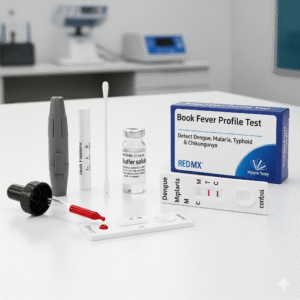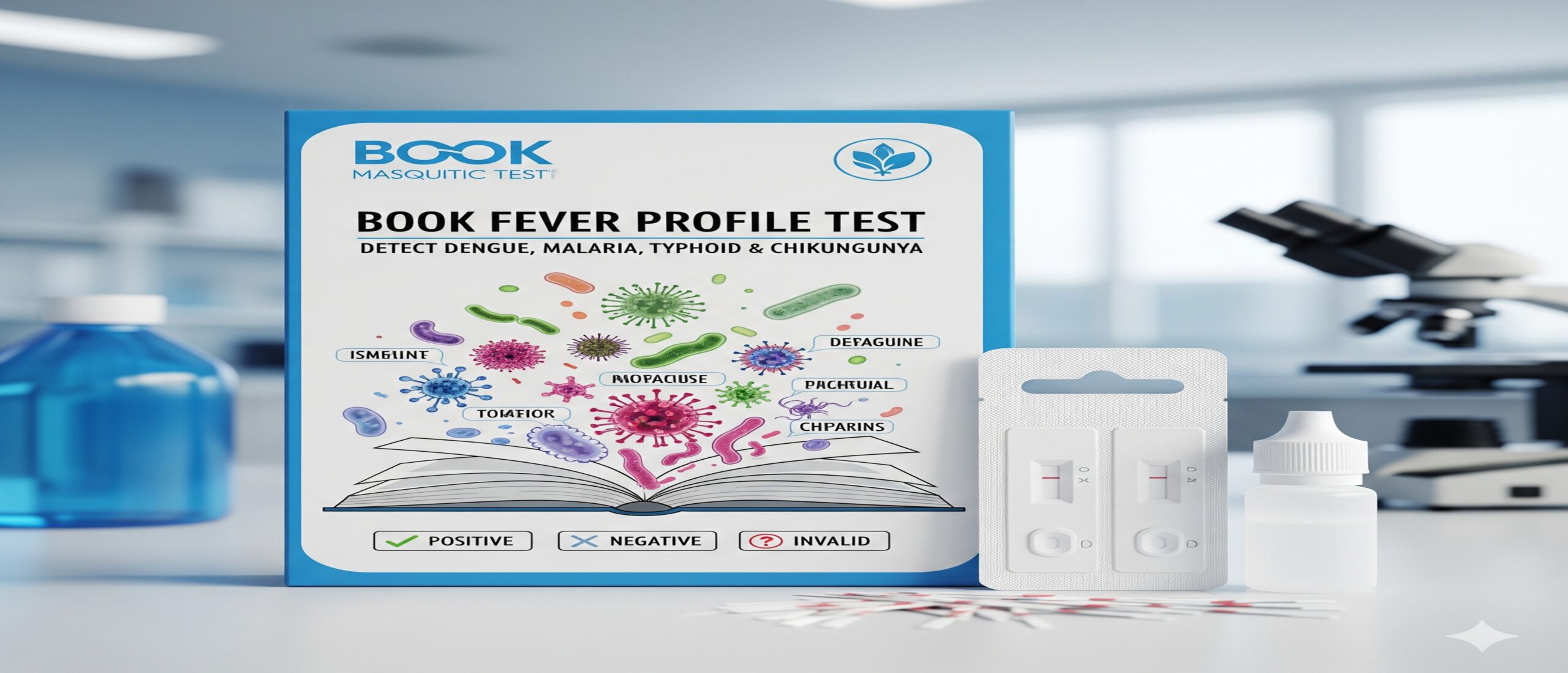Introduction to Fever Profile Test

Fever is one of the most common health complaints, but it can also be one of the most dangerous if ignored. A fever may seem like a simple rise in body temperature, but it can signal serious infections such as dengue, malaria, typhoid, or chikungunya. These illnesses often share overlapping symptoms, making it difficult to pinpoint the exact cause without proper testing. That’s where a fever profile test comes into the picture.
This test is a comprehensive diagnostic package that helps detect multiple infectious diseases in a single go. Instead of running separate tests for dengue, malaria, typhoid, and chikungunya, one fever profile test covers them all, saving both time and money.
Why Fever Needs Immediate Diagnosis
Fever is the body’s natural defense mechanism against infections. However, when the fever is persistent or very high, it is often a sign of a serious underlying illness. For example, dengue can cause a sudden drop in platelets, malaria may lead to severe anemia, typhoid can damage the intestines, and chikungunya causes long-term joint pain. Early testing ensures timely treatment and prevents dangerous complications.
The Importance of Detecting Multiple Infections Together
Since these diseases often occur during the same season and share similar symptoms such as high fever, body pain, fatigue, and headache, doctors recommend a fever profile test. Detecting multiple conditions together helps prevent misdiagnosis and ensures accurate treatment. Instead of treating only the symptoms, doctors can target the actual infection.
What is a Fever Profile Test?
A fever profile test is a combination of diagnostic tests designed to identify the root cause of fever. It checks for infections caused by bacteria, viruses, or parasites. By analyzing blood samples, it provides a detailed report that guides doctors in determining the best treatment plan.
Components of a Fever Profile Test

The test usually includes:
- CBC Test: Detects abnormalities in red and white blood cells.
- Dengue Test: Confirms dengue virus infection.
- Malaria Parasite Test: Identifies malaria-causing parasites in the blood.
- Widal Test: Checks for typhoid fever caused by Salmonella bacteria.
- Chikungunya Test: Detects chikungunya virus infection.
These combined tests provide a clearer and faster diagnosis than running them separately.
How the Test is Conducted
The procedure is simple:
- A blood sample is collected from the patient’s vein.
- The sample undergoes laboratory analysis for different infections.
- Reports are usually available within 24–48 hours.
No hospitalization is required, and the process is quick, painless, and safe.
Diseases Covered Under Fever Profile Test

The fever profile test is designed to diagnose four of the most common and serious fever-causing diseases: dengue, malaria, typhoid, and chikungunya.
Detecting Dengue Through Fever Profile
Dengue is a mosquito-borne viral infection spread by Aedes aegypti mosquitoes. The fever profile test helps detect the NS1 antigen or dengue antibodies in the blood. Since dengue symptoms resemble those of flu or viral fever, early testing is critical.
Detecting Malaria Through Fever Profile
Malaria is caused by parasites from the Plasmodium family, transmitted by Anopheles mosquitoes. The fever profile test checks for malaria parasites in the blood. Detecting malaria early prevents complications like cerebral malaria and organ failure.
Detecting Typhoid Through Fever Profile
Typhoid fever is a bacterial infection caused by Salmonella typhi. The fever profile test includes the Widal test, which identifies antibodies against typhoid bacteria. Since untreated typhoid can damage the intestines, prompt detection is vital.
Detecting Chikungunya Through Fever Profile
Chikungunya is another mosquito-borne viral infection that causes high fever and severe joint pain. The fever profile test detects IgM antibodies, confirming the presence of the chikungunya virus in the body.
Common Symptoms of Dengue, Malaria, Typhoid & Chikungunya
Since all four diseases cause fever and body pain, differentiating them without a test is nearly impossible.
Early Warning Signs of Dengue
- High fever (sudden onset)
- Severe headache
- Pain behind the eyes
- Joint and muscle pain
- Nausea and vomiting
- Drop in platelet count
Recognizing Malaria Symptoms
- High fever with chills and shivering
- Sweating after fever subsides
- Fatigue and weakness
- Headache and nausea
- Anemia in prolonged cases
Identifying Typhoid Symptoms
- Continuous high fever
- Abdominal pain and constipation/diarrhea
- Weakness and loss of appetite
- Rashes in some cases
- Slow pulse rate in severe infection
Symptoms of Chikungunya
- Sudden high fever
- Severe joint and muscle pain
- Headache and fatigue
- Skin rashes
- Long-lasting joint pain (even after fever subsides)
These overlapping symptoms highlight why a fever profile test is essential for correct diagnosis.
Why Book a Fever Profile Test?
Booking a fever profile test is one of the smartest healthcare decisions when dealing with an unexplained fever.
Early Detection Saves Lives
Diseases like dengue and malaria can turn life-threatening if not diagnosed on time. Early detection through a fever profile test ensures quick medical intervention.
Cost-Effective Testing Approach
Instead of paying for four separate tests, one fever profile test includes them all, making it affordable and efficient.
Preventing Misdiagnosis
Since dengue, malaria, typhoid, and chikungunya have similar symptoms, doctors may misdiagnose if only a single test is done. A fever profile test rules out confusion and ensures accuracy.
When Should You Book a Fever Profile Test?
Fever is one of the most common symptoms people experience, but not every fever is harmless. While some may be due to simple viral infections, others may signal serious diseases like dengue, malaria, typhoid, or chikungunya. Knowing when to book a fever profile test can make all the difference in preventing complications.
Persistent Fever Beyond 2–3 Days
If your fever continues for more than 48 to 72 hours despite taking basic fever-reducing medications, it is a red flag. Normal viral fevers often subside within a couple of days, but persistent high fever could indicate malaria or typhoid. In dengue, the fever may rise suddenly and remain high, while in chikungunya, the fever is often accompanied by joint pain. When the fever refuses to go away, booking a fever profile test is the safest step.
Seasonal Outbreaks and Risk Factors
Diseases like dengue and malaria often spike during monsoon and post-monsoon seasons due to increased mosquito breeding. Similarly, typhoid spreads more during summer due to water contamination, while chikungunya outbreaks occur in mosquito-prone areas. If you live in or travel to places where these diseases are prevalent, a fever profile test is highly recommended as soon as you notice fever and body pain.
Travel History and Exposure to Mosquito-Prone Areas
If you have recently traveled to areas with high mosquito activity, your chances of contracting malaria, dengue, or chikungunya increase significantly. Even if you use mosquito repellents or nets, the risk is never completely eliminated. In such cases, the fever profile test helps confirm or rule out infections quickly.
Benefits of Fever Profile Test Over Individual Tests
You might wonder, “Why not just test for one disease at a time?” The answer lies in the overlapping symptoms and the cost of multiple tests. A fever profile test is far more efficient and beneficial than taking separate diagnostic tests for each disease.
Time-Saving Diagnostic Approach
Instead of waiting for one report, consulting the doctor, and then going for another test, the fever profile test gives you all-in-one results. This means faster diagnosis and earlier treatment. In emergencies like dengue with falling platelet counts, time can make the difference between recovery and hospitalization.
Comprehensive Evaluation in One Go
The fever profile test doesn’t just check for a single infection—it screens for bacterial, viral, and parasitic causes of fever. This comprehensive evaluation helps doctors see the bigger picture instead of treating based on guesswork.
Accuracy and Reliability
Since the test includes multiple diagnostic checks, the chances of misdiagnosis reduce significantly. Even if one infection is ruled out, the test may detect another, ensuring no disease goes unnoticed. This improves treatment accuracy and patient outcomes.
Preparing for a Fever Profile Test
Most people don’t know that certain preparations can improve the accuracy of test results. Following simple guidelines can make the process smoother and more reliable.
Fasting and Pre-Test Guidelines
In most cases, fasting is not required for a fever profile test. However, depending on additional tests recommended by the doctor (like liver or kidney function tests), you may need to fast for 8–10 hours. Always clarify with your healthcare provider before the test. Drinking water is usually allowed, but avoid tea, coffee, or fruit juices before sample collection.
Medical History and Doctor’s Advice
Inform your doctor or technician about:
- Any ongoing medications (like antibiotics or antimalarials), as they may affect results.
- Recent vaccinations or illnesses, since they can interfere with antibody detection.
- Previous episodes of similar fever, which may indicate recurrence of diseases like malaria.
Proper preparation ensures that your fever profile test results are accurate and useful for diagnosis.
How Results Are Interpreted
Once your test reports are ready, the interpretation is crucial. While the laboratory provides results in numbers or positive/negative format, only a doctor can correctly analyze them in the context of your symptoms.
Understanding Positive and Negative Results
- A positive dengue antigen or antibody test confirms dengue infection.
- A positive malaria parasite test shows malaria-causing organisms in the blood.
- A positive Widal test indicates the presence of typhoid antibodies.
- A positive chikungunya IgM antibody test confirms recent chikungunya infection.
A negative result does not always mean you are free of infection—it could mean the disease is in an early stage, and repeat testing may be required.
Role of Doctors in Diagnosis
Doctors do not rely solely on test results; they also consider your symptoms, travel history, and exposure risks. For instance, if you have joint pain and fever but only borderline chikungunya test results, your doctor may still consider it a positive case based on your symptoms. This highlights the importance of professional medical guidance instead of self-diagnosis.
Treatment and Next Steps After Fever Profile Test
Once your fever profile test results are available, the doctor will create a treatment plan tailored to your condition. Since dengue, malaria, typhoid, and chikungunya require different treatments, accurate diagnosis ensures proper care.
Dengue Treatment Plan
- There is no specific antiviral treatment for dengue.
- Doctors focus on managing symptoms, especially fluid balance and platelet monitoring.
- Paracetamol is given for fever, but aspirin and ibuprofen are avoided as they increase bleeding risk.
- In severe cases, hospitalization and intravenous fluids may be required.
Malaria Treatment Plan
- Antimalarial drugs like chloroquine, artemisinin-based combination therapies (ACTs), or quinine are prescribed.
- The treatment depends on the malaria strain (Plasmodium vivax or Plasmodium falciparum).
- Supportive care includes hydration, fever control, and monitoring anemia.
Typhoid Treatment Plan
- Antibiotics like azithromycin or cefixime are commonly prescribed.
- Patients are advised to follow a light, easily digestible diet since typhoid affects the intestines.
- In severe cases, hospitalization may be required for intravenous antibiotics and fluids.
Chikungunya Treatment Plan
- Like dengue, there is no specific antiviral for chikungunya.
- Doctors focus on symptom relief, especially pain management with paracetamol.
- Rest and adequate hydration are crucial.
- Joint pain may persist for weeks or months, and physiotherapy or anti-inflammatory medications may be recommended.
Risks of Ignoring Fever Without Testing
Many people assume fever will go away with rest or over-the-counter medication. While this is true for minor viral fevers, ignoring persistent or recurring fever can be dangerous. If left undiagnosed, infections like dengue, malaria, typhoid, and chikungunya can cause severe complications, some of which may be life-threatening.
Complications of Untreated Dengue
Dengue can progress into dengue hemorrhagic fever or dengue shock syndrome if not detected on time. Both conditions can cause internal bleeding, dangerously low blood pressure, and even death. Platelet counts may drop to critical levels, making hospitalization and transfusion necessary. Ignoring dengue symptoms is highly risky, especially during seasonal outbreaks.
Complications of Malaria
Malaria, if untreated, can advance to cerebral malaria, which affects the brain and may lead to seizures, coma, or permanent brain damage. It can also cause severe anemia, liver and kidney failure, and complications in pregnant women. Delay in diagnosis often makes malaria harder to treat, especially if caused by drug-resistant parasites.
Complications of Typhoid
Typhoid is notorious for causing intestinal perforation if ignored, which can be fatal. Chronic untreated typhoid may also damage the liver, spleen, and heart. Some individuals may become carriers of the typhoid bacteria without knowing it, silently spreading the disease to others.
Complications of Chikungunya
Chikungunya rarely causes death, but the long-term impact can be crippling. Severe joint pain and arthritis-like symptoms can last for months or even years. Elderly people and those with weak immunity are at higher risk of developing prolonged joint complications.
These risks highlight why a fever profile test should never be delayed if fever persists or worsens.
Preventive Measures Against These Diseases
While diagnosis is important, prevention remains the best approach. By taking simple but effective measures, you can significantly reduce the risk of contracting dengue, malaria, typhoid, and chikungunya.
Protecting Against Mosquito-Borne Illnesses
Since dengue, malaria, and chikungunya are all mosquito-borne, prevention strategies focus on controlling mosquito breeding and avoiding bites.
- Use mosquito repellents, nets, and coils.
- Wear long-sleeved clothing, especially during evenings and early mornings.
- Avoid stagnant water around homes since mosquitoes breed in them.
- Regularly clean water storage containers and use covers.
Maintaining Food and Water Hygiene
Typhoid is spread mainly through contaminated food and water. Preventive steps include:
- Drinking only clean, filtered, or boiled water.
- Avoiding roadside food and beverages.
- Washing fruits and vegetables thoroughly.
- Practicing proper hand hygiene before eating.
Boosting Immunity Naturally
A strong immune system is your first line of defense against infections.
- Eat a balanced diet rich in vitamins, minerals, and antioxidants.
- Stay hydrated and get adequate sleep.
- Include immune-boosting foods like turmeric, garlic, ginger, and citrus fruits.
- Regular exercise also helps in maintaining overall health and resilience against infections.
Who Should Book a Fever Profile Test Immediately?
While anyone with unexplained fever can benefit from a fever profile test, certain groups are at higher risk and should not delay testing.
High-Risk Groups Like Children and Elderly
Children have developing immune systems, making them more vulnerable to infections like dengue and typhoid. Elderly individuals, on the other hand, may have weaker immunity and existing health conditions, making fever-related illnesses more dangerous.
People with Weak Immunity
Patients with chronic illnesses like diabetes, kidney disease, or heart problems, as well as those undergoing treatments like chemotherapy, are at higher risk of severe complications. Even a mild fever in such individuals requires immediate medical attention and a fever profile test.
Frequent Travelers
Those who travel frequently, especially to mosquito-prone or tropical regions, are at increased risk of contracting malaria, dengue, or chikungunya. Travelers should get tested quickly if they develop fever during or after their trips.
Cost and Availability of Fever Profile Test
The fever profile test is widely available across diagnostic centers and hospitals. Its cost is generally affordable considering the number of diseases it covers.
Average Cost Range
Depending on the city, healthcare provider, and additional parameters included, the fever profile test usually costs between INR 1,000 to 3,000 (or equivalent in other currencies). This makes it more cost-effective than booking four separate tests.
Home Collection and Convenience
Today, many diagnostic services offer home sample collection, making it easier for patients to get tested without stepping out. This is especially helpful for elderly patients, bedridden individuals, or those experiencing high fever and weakness. Results are usually available online within 24–48 hours.
Conclusion
A fever is not always just a minor health issue—it can be the first warning sign of life-threatening diseases like dengue, malaria, typhoid, and chikungunya. Since these illnesses share similar symptoms, a fever profile test is the most reliable way to detect the exact cause and begin timely treatment.
By booking a fever profile test, you not only save time and money but also protect yourself from complications that could arise from misdiagnosis or delayed treatment. Whether you are experiencing persistent fever, live in an outbreak-prone area, or fall into a high-risk group, this test can be a lifesaver.
Remember: early diagnosis saves lives. Don’t ignore prolonged fever—get tested, stay safe, and take preventive measures to keep yourself and your family healthy.
FAQs
Q1: How accurate is a fever profile test?
A fever profile test is highly accurate in detecting dengue, malaria, typhoid, and chikungunya when performed during the right stage of infection. In some cases, repeat testing may be recommended if symptoms persist.
Q2: Can a fever profile test detect all viral fevers?
No, the fever profile test is designed specifically for dengue, malaria, typhoid, and chikungunya. For other viral fevers, your doctor may suggest additional tests.
Q3: How long does it take to get results?
Most fever profile test results are available within 24–48 hours, depending on the diagnostic center.
Q4: Do I need a doctor’s prescription?
While a prescription is not always mandatory, it is advisable to consult a doctor for guidance before booking the test.
Q5: How often should I get tested during fever outbreaks?
If you develop a high fever during outbreak seasons, you should get tested immediately. Repeated testing is only necessary if symptoms persist or worsen despite treatment.


Leave a Reply